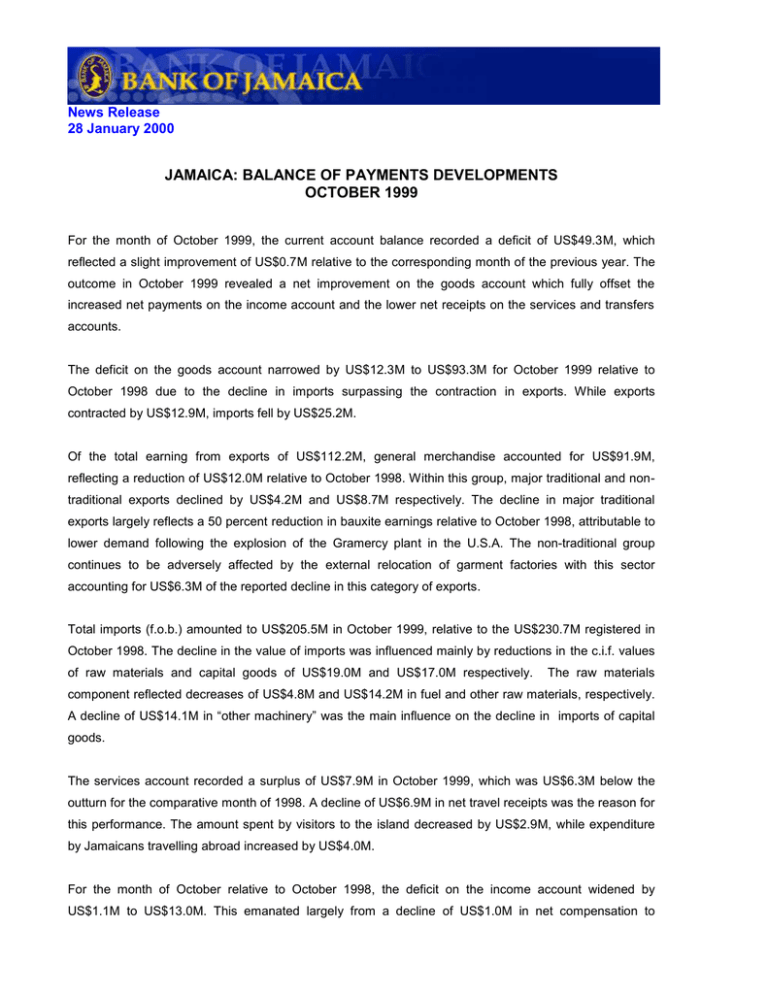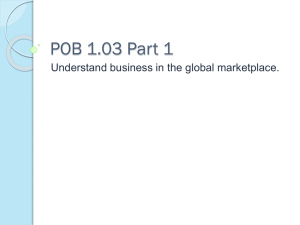JAMAICA: BALANCE OF PAYMENTS DEVELOPMENTS OCTOBER 1999 News Release
advertisement

News Release 28 January 2000 JAMAICA: BALANCE OF PAYMENTS DEVELOPMENTS OCTOBER 1999 For the month of October 1999, the current account balance recorded a deficit of US$49.3M, which reflected a slight improvement of US$0.7M relative to the corresponding month of the previous year. The outcome in October 1999 revealed a net improvement on the goods account which fully offset the increased net payments on the income account and the lower net receipts on the services and transfers accounts. The deficit on the goods account narrowed by US$12.3M to US$93.3M for October 1999 relative to October 1998 due to the decline in imports surpassing the contraction in exports. While exports contracted by US$12.9M, imports fell by US$25.2M. Of the total earning from exports of US$112.2M, general merchandise accounted for US$91.9M, reflecting a reduction of US$12.0M relative to October 1998. Within this group, major traditional and nontraditional exports declined by US$4.2M and US$8.7M respectively. The decline in major traditional exports largely reflects a 50 percent reduction in bauxite earnings relative to October 1998, attributable to lower demand following the explosion of the Gramercy plant in the U.S.A. The non-traditional group continues to be adversely affected by the external relocation of garment factories with this sector accounting for US$6.3M of the reported decline in this category of exports. Total imports (f.o.b.) amounted to US$205.5M in October 1999, relative to the US$230.7M registered in October 1998. The decline in the value of imports was influenced mainly by reductions in the c.i.f. values of raw materials and capital goods of US$19.0M and US$17.0M respectively. The raw materials component reflected decreases of US$4.8M and US$14.2M in fuel and other raw materials, respectively. A decline of US$14.1M in “other machinery” was the main influence on the decline in imports of capital goods. The services account recorded a surplus of US$7.9M in October 1999, which was US$6.3M below the outturn for the comparative month of 1998. A decline of US$6.9M in net travel receipts was the reason for this performance. The amount spent by visitors to the island decreased by US$2.9M, while expenditure by Jamaicans travelling abroad increased by US$4.0M. For the month of October relative to October 1998, the deficit on the income account widened by US$1.1M to US$13.0M. This emanated largely from a decline of US$1.0M in net compensation to employees. Net receipts from current transfers declined by US$4.2M to US$49.1M for October 1999 relative to October 1998. This was attributable to a US$4.6M decrease in the net receipts of the private The financial account recorded a surplus of US$47.9M for October 1999 relative to US$48.0M for October 1998. Net private investments recorded a surplus of US$30.4M, US$8.5M less than October 1998. Concurrently, net official investment outflows widened by US$13.7M to US$15.9M. The surplus on the private investment was not sufficient to cover the shortfall in official investment flows and the current account deficit. As a result there was a drawdown of US$33.4M in the net international reserves of the Bank of Jamaica. For the fiscal period April to October 1999/2000 relative to the corresponding period of 1998/99, the current account deficit widened by US$8.6M to US$137.1M. This performance was influenced by deterioration on all the sub-accounts with the exception of current transfers. The deficit of US$609.9M on the merchandise account was higher by US$5.2M for the review period relative to the corresponding period of the previous year. This was due to a reduction of US$81.4M in export earnings compared to a smaller decline of US$76.2M in the import bill. Total exports for the fiscal period amounted to US$882.8M, of which general merchandise accounted for US$724.1M, while free zone exports and goods procured in Jamaican ports were US$141.1M and US$17.5M, respectively. Within the general merchandise category, major traditional and non-traditional exports declined by US$36.7M and US$31.3M, respectively, compared to April to October 1998. Bauxite and bananas reflected lower export volumes while adverse commodity price movements affected sugar and alumina. A lower volume of sugar was also exported during the current fiscal review period. The fallout in the garment sector continued to influence the performance of non-traditional exports. The reduction in the value of imports was influenced by respective decreases of US$68.1M and US$29.1M in the c.i.f. values of raw materials and capital goods. Accounting for the decline in raw materials was non-fuel raw materials, which decreased by US$85.7M to US$630.6M. The decline in this category reflected mainly lower imports of food for processing, supplies for the garment sector and airplane parts. The decline in capital goods imports was largely influenced by respective declines of US$8.3M and US$18.2M in the transport and equipment and other machinery categories. For April to October 1999, the services account showed a lower surplus of US$255.6M relative to the surplus of US$262.8M recorded in the corresponding period of 1998/99. The lower surplus resulted from a decline in net travel receipts and an increase in net other services payments. The deficit on the income account widened by US$3.9M due to a lower surplus and an increase in net payments in compensation to employees and investment income respectively. Net inflows of current transfers increased by US$7.7M due solely to private transfers, as government transfers remained constant. For the fiscal period April to October 1999/2000, the capital account showed a surplus of US$6.4M, which was US$4.5M below the surplus recorded for the corresponding period of FY 1998/99. There was a surplus of US$130.7M on the financial account, representing an improvement of US$13.1M relative to the corresponding months of 1998/99. Private sector investment inflows increased by US$110.1M, while the outflows in official payments expanded by US$196.1M to US$231.0M. The level of net private investment inflows was insufficient to cover the shortfall in official sector flows as well as the current account deficit, thereby necessitating a drawdown of US$88.6M in the net international reserves of the Bank of Jamaica. The following table shows the balance of payments performance for October 1998 and 1999 and April to October 1998/99 and 1999/2000. BALANCE OF PAYMENTS SUMMARY (US$M) 1. CURRENT ACCOUNT A. GOODS and SERVICES a. GOODS BALANCE Exports (f.o.b.) Imports (f.o.b.) b. SERVICES BALANCE Transportation Travel Other Services B. INCOME Compensation of employees Investment Income C. CURRENT TRANSFERS Official Private 2. CAPITAL & FINANCIAL ACCOUNT A. CAPITAL ACCOUNT a. Capital Transfers Official Private b. Acq./disposal of non-prod. non-fin'l assets B. FINANCIAL ACCOUNT Other official investment Other private investment 3/ Reserves 1/ Revised 2/ Provisional 3/ Includes errors & omissions BANK OF JAMAICA 1/ Oct 2/ Oct 1/ Apr-Oct 2/ Apr-Oct 1998 1999 1998/99 1999/2000 -50.0 -91.4 -105.6 125.1 230.7 14.2 -26.5 53.8 -13.1 -11.9 13.4 -25.3 53.3 3.8 49.5 50.0 2.0 2.0 1.1 0.9 0.0 48.0 -2.2 38.9 11.3 -49.3 -85.4 -93.3 112.2 205.5 7.9 -25.3 46.9 -13.7 -13.0 12.4 -25.4 49.1 4.2 44.9 49.3 1.4 1.4 0.5 0.9 0.0 47.9 -15.9 30.4 33.4 -128.5 -341.9 -604.7 964.2 1568.9 262.8 -159.2 541.9 -119.9 -158.4 41.6 -200.0 371.8 28.3 343.5 128.5 10.9 10.9 3.3 7.6 0.0 117.6 -34.9 163.0 -10.5 -137.1 -354.3 -609.9 882.8 1492.7 255.6 -145.1 526.8 -126.1 -162.3 39.3 -201.6 379.5 28.3 351.2 137.1 6.4 6.4 1.4 5.0 0.0 130.7 -231.0 273.1 88.6





